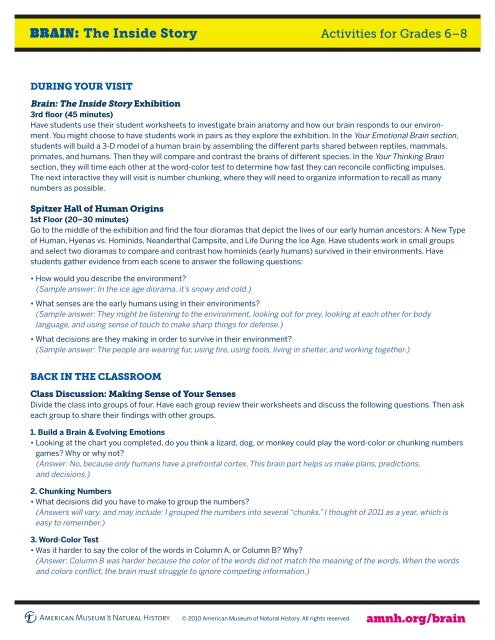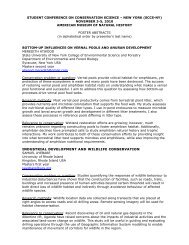Brain: The Inside Story: Activities for Grades 6-8 - American Museum ...
Brain: The Inside Story: Activities for Grades 6-8 - American Museum ...
Brain: The Inside Story: Activities for Grades 6-8 - American Museum ...
You also want an ePaper? Increase the reach of your titles
YUMPU automatically turns print PDFs into web optimized ePapers that Google loves.
BRAIN: <strong>The</strong> <strong>Inside</strong> <strong>Story</strong> <strong>Activities</strong> <strong>for</strong> <strong>Grades</strong> 6–8DURING YOUR VISIT<strong>Brain</strong>: <strong>The</strong> <strong>Inside</strong> <strong>Story</strong> Exhibition3rd floor (45 minutes)Have students use their student worksheets to investigate brain anatomy and how our brain responds to our environment.You might choose to have students work in pairs as they explore the exhibition. In the Your Emotional <strong>Brain</strong> section,students will build a 3-D model of a human brain by assembling the different parts shared between reptiles, mammals,primates, and humans. <strong>The</strong>n they will compare and contrast the brains of different species. In the Your Thinking <strong>Brain</strong>section, they will time each other at the word-color test to determine how fast they can reconcile conflicting impulses.<strong>The</strong> next interactive they will visit is number chunking, where they will need to organize in<strong>for</strong>mation to recall as manynumbers as possible.Spitzer Hall of Human Origins1st Floor (20–30 minutes)Go to the middle of the exhibition and find the four dioramas that depict the lives of our early human ancestors: A New Typeof Human, Hyenas vs. Hominids, Neanderthal Campsite, and Life During the Ice Age. Have students work in small groupsand select two dioramas to compare and contrast how hominids (early humans) survived in their environments. Havestudents gather evidence from each scene to answer the following questions:• How would you describe the environment?(Sample answer: In the ice age diorama, it’s snowy and cold.)• What senses are the early humans using in their environments?(Sample answer: <strong>The</strong>y might be listening to the environment, looking out <strong>for</strong> prey, looking at each other <strong>for</strong> bodylanguage, and using sense of touch to make sharp things <strong>for</strong> defense.)• What decisions are they making in order to survive in their environment?(Sample answer: <strong>The</strong> people are wearing fur, using fire, using tools, living in shelter, and working together.)BACK IN THE CLASSROOMClass Discussion: Making Sense of Your SensesDivide the class into groups of four. Have each group review their worksheets and discuss the following questions. <strong>The</strong>n askeach group to share their findings with other groups.1. Build a <strong>Brain</strong> & Evolving Emotions• Looking at the chart you completed, do you think a lizard, dog, or monkey could play the word-color or chunking numbersgames? Why or why not?(Answer: No, because only humans have a prefrontal cortex. This brain part helps us make plans, predictions,and decisions.)2. Chunking Numbers• What decisions did you have to make to group the numbers?(Answers will vary, and may include: I grouped the numbers into several “chunks.” I thought of 2011 as a year, which iseasy to remember.)3. Word-Color Test• Was it harder to say the color of the words in Column A, or Column B? Why?(Answer: Column B was harder because the color of the words did not match the meaning of the words. When the wordsand colors conflict, the brain must struggle to ignore competing in<strong>for</strong>mation.)© 2010 <strong>American</strong> <strong>Museum</strong> of Natural History. All rights reserved.amnh.org/brain
















